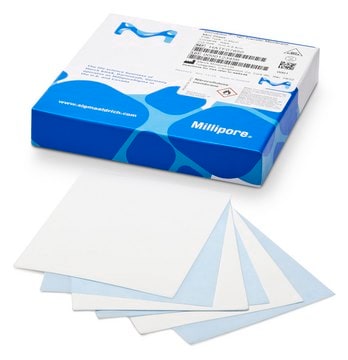HATF00010
Immobilon® -NC Nitrocellulose Membrane
1 roll, 33 cm x 3 m, 0.45 µm pore size, Triton-free, nitrocellulose-based transfer membrane
Synonym(s):
Western blotting membrane, blotting membrane, nitrocellulose transfer membrane, transfer membrane
About This Item
Recommended Products
product name
Immobilon®-NC Transfer Membrane, 1 roll, 33 cm x 3 m, 0.45 µm pore size, Triton-free, mixed cellulose esters transfer membrane
material
mixed cellulose esters (MCE) membrane
nitrocellulose membrane
plain filter
white filter
Quality Level
feature
hydrophilic
manufacturer/tradename
Immobilon®
technique(s)
western blot: suitable
filter L × W
33 cm × 3 m
pore size
0.45 μm pore size
capacity
117 μg/cm2 adsorption capacity (insulin)
160 μg/cm2 adsorption capacity (BSA)
259 μg/cm2 adsorption capacity (goat IgG)
compatibility
for use with Amido black
for use with CPTS
for use with Colloidal gold
for use with India ink
for use with Ponceau-S red
detection method
chemiluminescent
colorimetric
fluorometric
radioactive
shipped in
ambient
Related Categories
General description
Application
Legal Information
Signal Word
Danger
Hazard Statements
Precautionary Statements
Hazard Classifications
Flam. Sol. 1
Storage Class Code
4.1B - Flammable solid hazardous materials
WGK
WGK 3
Certificates of Analysis (COA)
Search for Certificates of Analysis (COA) by entering the products Lot/Batch Number. Lot and Batch Numbers can be found on a product’s label following the words ‘Lot’ or ‘Batch’.
Already Own This Product?
Find documentation for the products that you have recently purchased in the Document Library.
Customers Also Viewed
Protocols
Protocol for sample preparation for cell lysis and efficient protein extraction from cultured tissues and cells for subsequent Western blotting.
Protocol for sample preparation for cell lysis and efficient protein extraction from cultured tissues and cells for subsequent Western blotting.
Protocol for sample preparation for cell lysis and efficient protein extraction from cultured tissues and cells for subsequent Western blotting.
Protocol for sample preparation for cell lysis and efficient protein extraction from cultured tissues and cells for subsequent Western blotting.
Our team of scientists has experience in all areas of research including Life Science, Material Science, Chemical Synthesis, Chromatography, Analytical and many others.
Contact Technical Service












